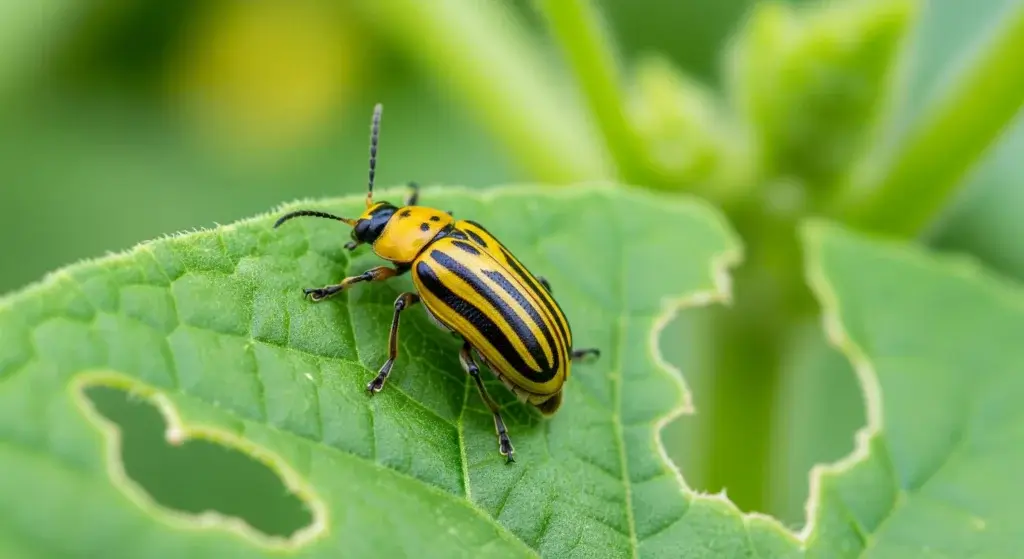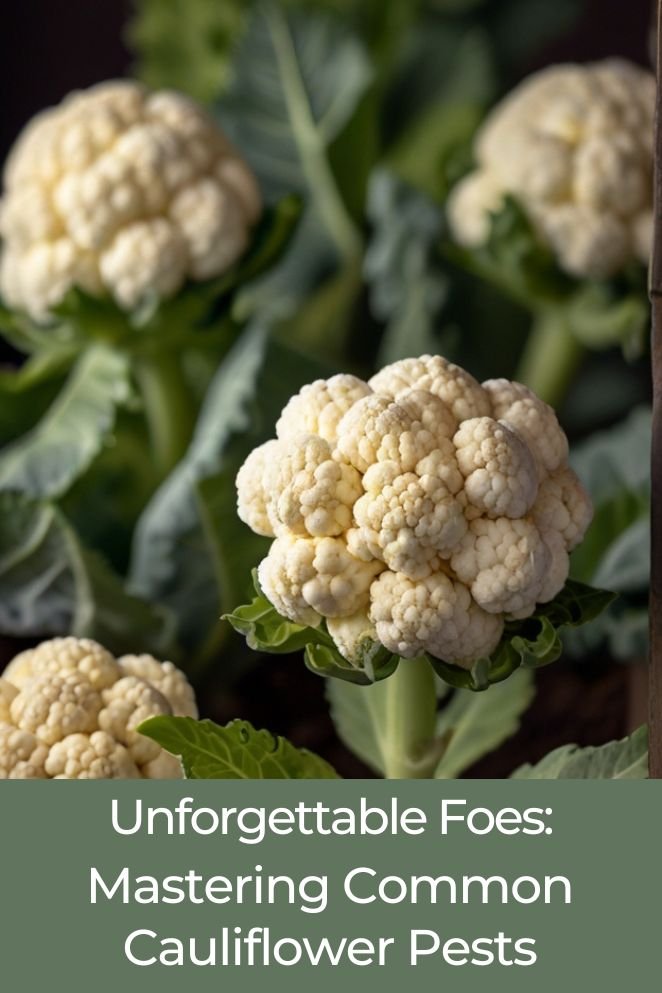
Cauliflower, with its beautiful white florets, is a delicious and versatile vegetable.
But like any crop, it can be susceptible to a variety of pests that can damage your precious harvest.
This blog post will equip you with the knowledge to identify and combat the most common cauliflower enemies, ensuring a healthy and bountiful crop.
Common Cauliflower Pests
Cauliflower can fall victim to various pests that can wreak havoc on your plants if left unchecked.
Here’s a breakdown of the most common cauliflower pests and the damage they can cause:
- Read also: A Guide to Watering Your Cauliflower Plants
- Read also: Organic Pest Control For Cauliflower
Chewing insects (such as caterpillars)
These pests have a voracious appetite for cauliflower leaves and stems.
They chew through foliage, creating unsightly holes and causing damage that can compromise the plant’s overall health.
If left untreated, chewing insects can significantly reduce plant vigor and yield.
Type of damage
- Holes in leaves and stems: Chewing insects leave behind distinct holes in cauliflower leaves and stems, which can weaken the plant and make it more susceptible to diseases.
- Reduced plant vigor: As chewing insects continue to feed on the plant, it may experience a decline in vigor, resulting in stunted growth and poor overall health.
- Reduced yield: Damage inflicted by chewing insects can hinder the cauliflower plant’s ability to produce healthy heads, ultimately leading to a diminished yield at harvest time.
Sucking insects (like aphids and whiteflies):
These pests target the sap of cauliflower plants, extracting nutrients and moisture from the foliage.
As they feed, they can cause stunted growth and discoloration of the leaves, depriving the plant of vital resources.
Type of damage
- Stunted growth: Sucking insects disrupt the normal growth patterns of cauliflower plants, inhibiting their development and leading to smaller, less robust specimens.
- Yellowing of leaves: The damage caused by sucking insects can manifest as yellowing or distortion of cauliflower leaves, signaling stress and nutrient deficiencies.
- Reduced yield: Prolonged infestations of sucking insects can impede the cauliflower plant’s ability to produce healthy heads, resulting in a diminished harvest.
Soil-borne Pests (such as root maggots)
These pests target the roots of cauliflower plants, burrowing into the soil and feeding on the root system.
This can lead to wilting, reduced vigor, and ultimately, the death of the plant.
Type of damage
- Wilting: As soil-borne pests damage the root system, the cauliflower plant may struggle to absorb water and nutrients, resulting in wilting and drooping foliage.
- Reduced plant vigor: Root damage can impair the cauliflower plant’s ability to thrive, leading to decreased vigor and overall health.
- Eventual death of the plant: Without a healthy root system to support its growth, the cauliflower plant may succumb to soil-borne pests, resulting in its demise.
Slugs and Snails
These pests are notorious for munching on cauliflower leaves and stems, leaving behind ragged edges and causing damage that can impede plant growth and productivity.
Type of damage
- Holes in leaves and stems: Slugs and snails leave behind characteristic holes in cauliflower foliage as they feed, compromising the plant’s structural integrity.
- Reduced plant vigor: Continuous feeding by slugs and snails can weaken the cauliflower plant, leading to diminished vigor and poor performance.
- Reduced yield: Damage inflicted by these pests can hinder the cauliflower plant’s ability to produce healthy heads, resulting in a decreased yield come harvest time.
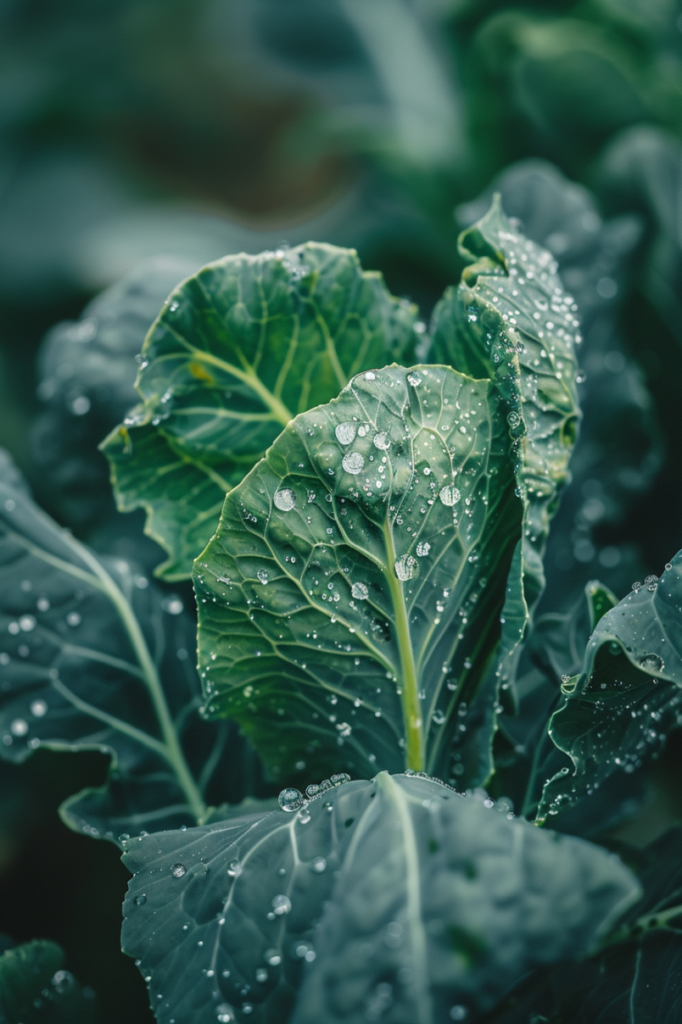
Signs of Pest Presence
Detecting the presence of pests on your cauliflower plants is crucial for timely intervention and effective pest management.
Here are the signs to look out for:
Chewing insects
- Holes in leaves and stems: One of the most visible signs of chewing insect infestation is the presence of irregularly shaped holes in cauliflower leaves and stems.
- Frass (insect droppings) on leaves: Chewing insects often leave behind droppings, known as frass, on the surface of cauliflower leaves.
- Presence of insects on the plant: Actively searching for chewing insects on the cauliflower plant itself is another indicator of infestation.
Sucking insects
- Stunted growth: Sucking insects extract sap from cauliflower plants, depriving them of essential nutrients and moisture.
- Yellowing of leaves: The feeding activity of sucking insects can cause yellowing or discoloration of cauliflower leaves, indicating stress and nutrient deficiency.
- Presence of insects on the plant: Similarly to chewing insects, the presence of sucking insects on the cauliflower plant itself is a clear sign of infestation.
Soil-borne pests
- Wilting: Soil-borne pests such as root maggots damage the root system of cauliflower plants, hindering their ability to absorb water and nutrients from the soil.
- Reduced plant vigor: They may appear smaller or less robust compared to unaffected plants, with pale or yellowed foliage indicating nutrient deficiencies.
- Presence of insects or larvae in the soil: Inspecting the soil around the base of cauliflower plants may reveal the presence of soil-borne pests or their larvae.
Slugs and Snails
- Holes in leaves and stems: Slugs and snails feed on cauliflower leaves and stems, leaving behind ragged edges and characteristic damage.
- Slime trails: Slugs and snails secrete a slimy mucus as they move across surfaces, leaving behind shiny trails on cauliflower leaves and stems.
- Presence of slugs or snails on the plant: Actively searching for slugs or snails on the cauliflower plant, particularly during the evening or early morning hours, can help confirm their presence.
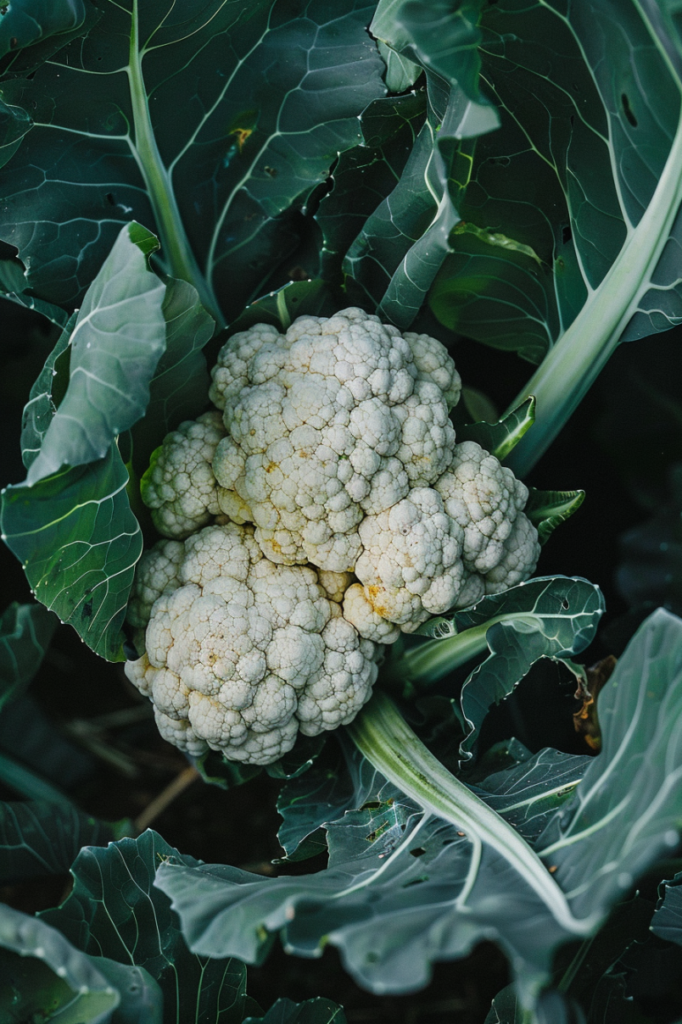
Pest Management Strategies
Effectively managing pests on your cauliflower plants is essential for maintaining a healthy and productive crop. Here are various strategies you can employ:
Non-Chemical Control Methods
Cultural practices
Utilize organic mulches
Applying organic mulches around the base of cauliflower plants can help deter pests by creating a barrier between the soil and foliage.
Mulches also help maintain soil moisture levels and regulate temperature, creating a healthier environment for plants.
Rotate crops
Practicing crop rotation helps disrupt pest cycles and reduce the buildup of pest populations in the soil.
By alternating the location of cauliflower plants with other crops each season, you can minimize pest pressure and maintain soil health.
Biological control
Introduce natural enemies
Beneficial insects such as ladybugs and parasitic wasps can be introduced to the garden to help control pest populations.
Ladybugs feed on aphids, while parasitic wasps lay their eggs inside caterpillars, effectively reducing their numbers.
Physical control
Handpick insects
Regularly inspect cauliflower plants and manually remove any visible pests, such as caterpillars or slugs.
This method is particularly effective for small-scale infestations and can help prevent pest populations from spiraling out of control.
Use row covers
Covering cauliflower plants with row covers or floating row covers can protect them from pest infestations.
These covers act as physical barriers, preventing insects from reaching the plants while still allowing sunlight, air, and water to penetrate.
Sticky traps
Place sticky traps around the perimeter of the garden or directly on cauliflower plants to monitor and control pest populations.
These traps attract flying insects such as whiteflies and aphids, trapping them on the sticky surface and preventing them from reaching the plants.
Chemical Control Methods (Optional)
Pesticides
Insecticidal soap
Insecticidal soap is a natural, low-toxicity pesticide that effectively controls soft-bodied insects such as aphids, whiteflies, and caterpillars.
It works by disrupting the cell membranes of pests, ultimately leading to their demise.
Neem oil
Neem oil is derived from the seeds of the neem tree and acts as a broad-spectrum insecticide, fungicide, and miticide.
It targets a wide range of pests, including chewing and sucking insects, while also providing some protection against fungal diseases.
Other approved pesticides
When necessary, you can use other approved pesticides to control pest infestations on cauliflower plants.
It’s essential to carefully read and follow label instructions to ensure safe and effective application.
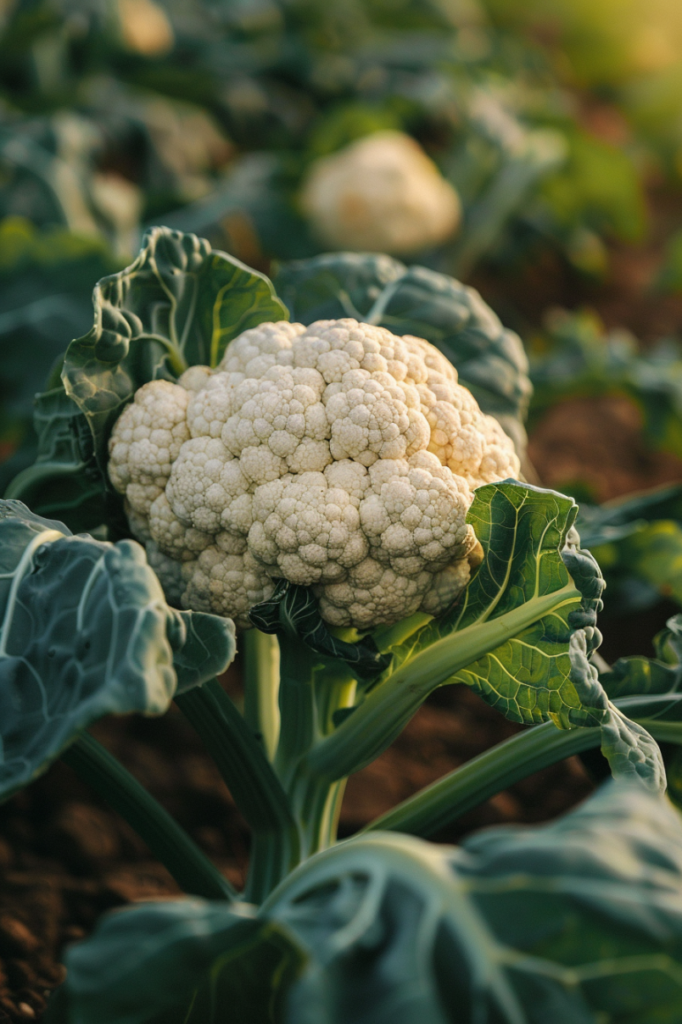
How to Prevent Pests on Cauliflower
Preventing pests on your cauliflower plants requires proactive measures and careful attention to garden management.
Here are steps you can take to keep pests at bay:
Maintain garden hygiene
- Keep your garden tidy: Regularly remove plant debris, fallen leaves, and weeds from your garden beds.
- Clear away debris: Eliminate any accumulated debris around your cauliflower plants, including dead foliage and leftover plant material.
Regular inspections
- Monitor cauliflower plants: Conduct regular inspections of your cauliflower plants to check for signs of pest presence.
- Be vigilant: Pay close attention to the undersides of leaves, where many pests like to hide.
Use row covers
- Shield your plants: Install row covers over your cauliflower plants to create a physical barrier that prevents pests from accessing the foliage.
- Secure covers properly: Ensure that row covers are securely anchored to the ground to prevent pests from crawling underneath.
Companion planting
- Choose compatible companions: Incorporate companion plants, such as collard greens or aromatic herbs like thyme or mint, into your garden layout.
- Diversify plantings: Interplanting cauliflower with compatible companion plants creates a more diverse and resilient ecosystem, making it less hospitable to pests that target a specific crop.
Proper watering
- Water with care: Ensure that your cauliflower plants receive consistent and adequate water, but avoid overwatering.
- Use drip irrigation or soaker hoses: Opt for drip irrigation or soaker hoses to deliver water directly to the root zone of cauliflower plants.
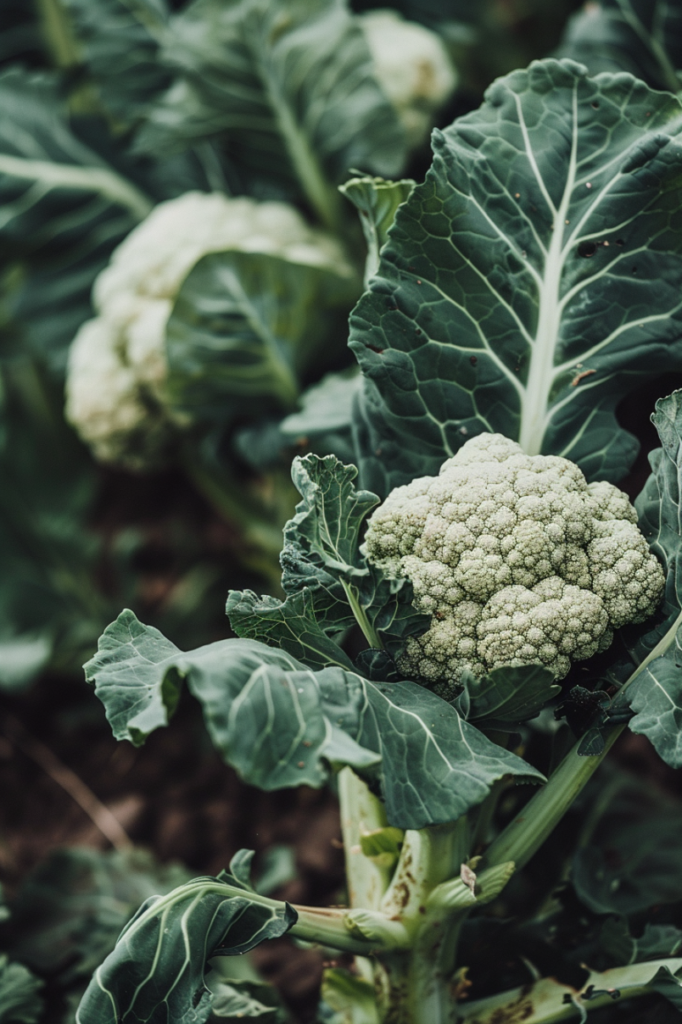
- Read also: Safe Indoor Plant Insect Sprays
- Read also: Cauliflower Powerhouse: The Nutrient Riches For Cauliflower
Conclusion
To safeguard your cauliflower crop, it’s essential to grasp the common pests that can harm it and the damage they cause.
By employing both non-chemical and chemical control techniques, you can shield your cauliflower plants and secure a fruitful harvest.


